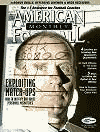AMERICAN FOOTBALL MONTHLY THE #1 RESOURCE FOR FOOTBALL COACHES
Article CategoriesAFM Magazine
|
An Eye for your Opponentsby: Matt Fulks© More from this issue Mike Van Deist keeps a close eye on personel match-ups and ways to exploit them. Itís been repeated almost too many times to say again. But, here you go: defense wins championships. Hold the urge to roll your eyes until you look at Carroll College in Montana. During Mike Van Diestís seven-year reign as head coach at Carroll, the Saints have become an NAIA powerhouse, winning the national championship the last four years after reaching the semifinals six straight times. It stands to reason that when it comes to preparing his teams, Van Diest knows how to scout his opponents, including the three important positions for a team that expects to compete in the pass-friendly Frontier Conference Ė defensive backs, the offensive line and wide receivers. With all three positions, Van Dies....The full article can only be seen by subscribers. Subscribe today!
|
|
|||||||
| HOME |
MAGAZINE |
SUBSCRIBE | ONLINE COLUMNISTS | COACHING VIDEOS |
Copyright 2025, AmericanFootballMonthly.com
All Rights Reserved





